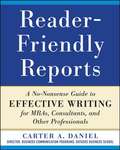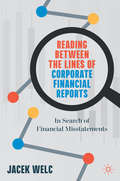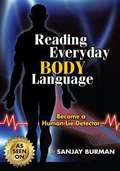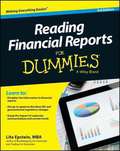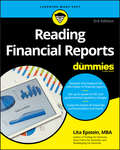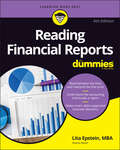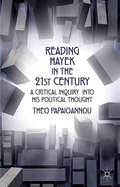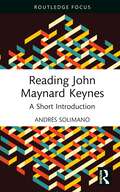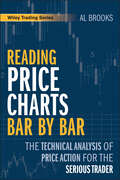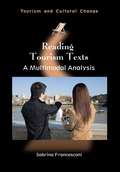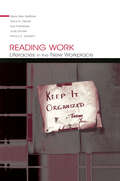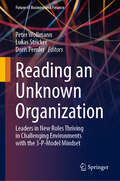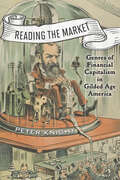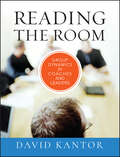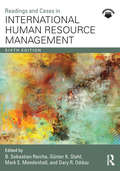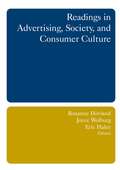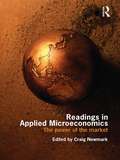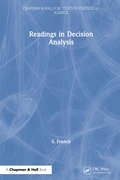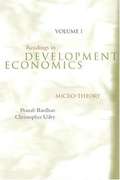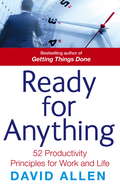- Table View
- List View
Reader-Friendly Reports: A No-Nonsense Guide To Effective Writing For MBAs, Consultants, And Other Professionals
by Carter A. DanielFor more than 30 years, Carter A. Daniel has been teaching MBA students at Rutgers University the art of effective business communication with the aid of his eminently practical guide Reader-Friendly Reports. <P><P> Now available to the public for the first time, this beloved resource gives you everything you need to translate your hard-won figures, conclusions, and insights into concise and powerful reports. No definition of communication, no history, no theory, no diagrams Reader-Friendly Reports simply shows you how to: <P><P> Target your audience <br>Determine your purpose <br>Develop your points <br>Organize your ideas <br>Make smooth transitions <br>Conduct research <br>Illustrate with clear graphs and charts <P><P>Reader-Friendly Reports (the “Daniel Manual”) is the A to Z guide to ensuring you meet your first priority: making sure people can understand and remember your report from beginning to end.
Reading Between the Lines of Corporate Financial Reports: In Search of Financial Misstatements
by Jacek WelcThis book provides a digestible step-by-step guide to reading corporate financial reports, drawing upon real-life case studies and examples of corporate collapses and accounting scandals, and applying practical tools to financial statement analysis. Appealing to a range of practitioners within corporate finance including investors, managers, and business analysts, this book is the first to specifically address the challenges facing those who are not professional accountants and auditors when examining corporate financial reports.Corporate financial reports are used widely by managers, investors, creditors, and government agencies to examine company performance and evaluate potential risks. However, although seemingly an invaluable source of information for managerial decision-making, financial reports are often based on rough simplifications of a very complex reality. With no way of avoiding deliberate manipulations and fraudulent activity, these statements cannot be relied on completely when selecting stocks or evaluating credit risk, and therefore poor analysis can lead to potentially disastrous investment decisions.The author suggests that in order to effectively interpret corporate financial reports, we must 'read between the lines' to accurately assess a company's economic performance and predict its long-term viability.
Reading Everyday Body Language
by Sanjay BurmanWe all have wondered if we are being told the truth.Well now you no longer have to wonder.Success requires trust in those who surround us and they are speaking to uswithout even talking, if we know how to read the signs.
Reading Financial Reports For Dummies
by Lita EpsteinDiscover how to decipher financial reportsEspecially relevant in today's world of corporate scandals and new accounting laws, the numbers in a financial report contain vitally important information about where a company has been and where it is going.Packed with new and updated information, Reading Financial Reports For Dummies, 3rd Edition gives you a quick but clear introduction to financial reports-and how to decipher the information in them.New information on the separate accounting and financial reporting standards for private/small businesses versus public/large businessesNew content to match SEC and other governmental regulatory changesNew information about how the analyst-corporate connection has actually changed the playing fieldThe impact of corporate communications and new technologiesNew examples that reflect current trendsUpdated websites and resourcesReading Financial Reports For Dummies is for investors, traders, brokers, managers, and anyone else who is looking for a reliable, up-to-date guide to reading financial reports effectively.
Reading Financial Reports For Dummies
by Lita EpsteinReading Financial Reports For Dummies, 3rd Edition (9781119543954) was previously published as Reading Financial Reports For Dummies, 3rd Edition (9781118761939). While this version features a new Dummies cover and design, the content is the same as the prior release and should not be considered a new or updated product. Discover how to decipher financial reports Especially relevant in today's world of corporate scandals and new accounting laws, the numbers in a financial report contain vitally important information about where a company has been and where it is going. Packed with new and updated information, Reading Financial Reports For Dummies, 3rd Edition gives you a quick but clear introduction to financial reports–and how to decipher the information in them. New information on the separate accounting and financial reporting standards for private/small businesses versus public/large businesses New content to match SEC and other governmental regulatory changes New information about how the analyst-corporate connection has actually changed the playing field The impact of corporate communications and new technologies New examples that reflect current trends Updated websites and resources Reading Financial Reports For Dummies is for investors, traders, brokers, managers, and anyone else who is looking for a reliable, up-to-date guide to reading financial reports effectively.
Reading Financial Reports For Dummies
by Lita EpsteinYour personal roadmap to becoming fluent in financial reports At first glance, the data in financial reports might seem confusing or overwhelming. But, with the right guide at your side, you can learn to translate even the thickest and most complex financial reports into plain English. In Reading Financial Reports For Dummies, you'll move step-by-step through each phase of interpreting and understanding the data in a financial report, learning the key accounting and business fundamentals as you go. The book includes clear explanations of basic and advanced topics in finance, from the difference between private and public companies to cash flow analysis. In this book, you'll also find: Full coverage of how to analyze annual reports, including their balance sheets, income statements, statements of cash flow, and consolidated statements Real-world case studies and financial statement examples from companies like Mattel and Hasbro Strategies for analyzing financial reports to reveal opportunities for operations optimization Reading Financial Reports For Dummies is a can't-miss resource for early-career investors, traders, brokers, and business leaders looking to improve their financial literacy with a reliable, accurate, and easy-to-follow financial handbook.
Reading Hayek in the 21st Century
by Theo PapaioannouPapaioannou offers a radical new reading of Hayek in the 21st century, arguing that the moral dimension of his political theory is based on the methodological implications of an epistemologically founded morality, a morality that must respect the natural limits of human knowledge.
Reading John Maynard Keynes: A Short Introduction (Routledge Focus on Economics and Finance)
by Andrés SolimanoThis book focuses on understanding the thinking of one of the greatest economists of the 20th century, John Maynard Keynes (JMK), stressing the evolution of his thinking from adherence to the classic Quantity Theory of Money to the development of his own novel theories of unemployment, stagnation and instability in modern capitalism and the need to have active policies to combat these malaises.The author dissects Keynes’s three main analytical works that shaped his thinking and policy recommendations: A Tract on Monetary Reform (1923); A Treatise on Money (1930); and The General Theory of Employment, Interest and Money (1936). Thia book undertakes a direct analysis of the texts of each of these three books themselves, rather than drawing on secondary literature studying what Keynes “wanted to say” according to other authors sympathetic or unsympathetic with Keynes’s ideas. It is an ideal text for a reader who wants to know in clear terms the thought of JMK and the historical context in which it evolved and developed.This book will be of significant interest to scholars, students and social researchers in various fields who are often surrounded by excessively technically oriented books about Keynes that often omit the history of ideas.
Reading Price Charts Bar by Bar
by Al BrooksWhile new technology and complicated theories promise to take your trading to "the next level," the truth is that long-term success in this field is rooted in simplicity. That's why Al Brooks has created Reading Price Charts Bar by Bar.With this book, Brooks--a technical analyst for Futures magazine and an independent trader--demonstrates how applying price action analysis to chart patterns can help enhance returns and minimize downside risk. Along the way, you'll discover the importance of understanding every bar on a price chart, why particular patterns are reliable setups for trades, and how to locate entry and exit points as markets are trading in real time.Throughout these pages, some of the most useful tools for deciphering price action are covered in detail, including:Trendlines and trend channel linesPrior highs and lowsBreakouts and failed breakoutsThe size of bodies and tails on candlesThe relationship between current bars to prior barsAnd much moreLearning what the market is telling you can be difficult, but with the right approach, you can achieve this goal and capture consistent profits in the process. Reading Price Charts Bar by Bar has all the information you need to succeed at this endeavor and will put you in the best position possible to make the most of your time in today's turbulent markets.Praise for Reading Price Charts Bar by Bar"Al Brooks has written a book every day trader should read. On all levels, he has kept trading simple, straightforward, and approachable. By teaching traders that there are no rules, just guidelines, he has allowed basic common sense to once again rule how real traders should approach the market. This is a must-read for any trader that wants to learn his own path to success."--Noble DraKoln, founder ofwww.SpeculatorAcademy.com and author of Trade Like a Pro and Winning the Trading Game"Al Brooks is a trader's trader. He understands the focused energy it takes to be successful at trading and works long, hard hours in front of the computer screen to beat the markets. In his first trading book, he outlines, selflessly, his strategy step by step. A doctor and educator in his previous life, he uses his eye for detail and transfers lessons he learned in training himself on the art of trading to the written page. For those who are willing to delve into the details of day trading and dedicate the time and energy to do it seriously and most likely profitably, Al Brooks's book Reading Price Charts Bar by Bar, is a must-read."--Ginger Szala, Publisher and Editorial Director, Futures magazine
Reading Rehabilitation Hospital: Implementing Patient-Focused Care
by Mason Brown Jody Hoffer GittellReading Rehab Hospital has experimented with a popular new concept in health care--patient-focused care--intended to increase quality and reduce costs by organizing care delivery around particular diagnoses or "service lines," rather than around the functions or disciplines of the care providers. It is equivalent to product rather than process focus. Rehabilitation involves multiple disciplines which must share information about their evaluations of the patient, about planned treatments, and about patient progress. The decisions and actions of one care provider depend on those of another. This case illustrates the effects of a problem fundamental to service operations--variable demand and the limitations of organizing production by service lines under conditions of uncertain demand, due to the loss of pooling. Finally, its methods, for achieving the coordination benefits of service lines under conditions where the level or stability of demand is insufficient to justify the use of service lines.
Reading Rehabilitation Hospital: Implementing Patient-Focused Care (A) (Abridged)
by Mason Brown Roy D. ShapiroReading Rehab Hospital has experimented with a popular concept in health care--patient-focused care--intended to increase quality and reduce costs by organizing care delivery around particular diagnoses or "service lines," rather than around the functions or disciplines of the care providers. It is equivalent to a product rather than a process focus. Unfortunately, it is not clear whether the benefits of this new healthcare model are sufficient to compensate for the drawbacks.
Reading Tourism Texts
by Sabrina FrancesconiThis volume explores the relationship between tourism and travel texts and contemporary society, and how each is shaped by the other. A multimodal analysis is used to consider a variety of texts including novels, brochures, blogs, websites, radio commercials, videos, postcards and authentic tourist pictures and their meaning-making dynamics within the tourism discourse. The book looks at the ways in which these different texts have influenced how tourists and travellers have been viewed over time and how we envision ourselves as tourists or travellers. It puts forward multimodal analysis as the best framework for exploring the semiotic potential of these texts. Including examples from the UK, Malta, Canada, New Zealand, India, Jamaica and South Africa, this volume will be useful for researchers and students in tourism studies, communication and media studies and applied linguistics.
Reading Work: Literacies in the New Workplace
by Nancy S. Jackson Mary Ellen Belfiore Tracy A. Defoe Sue Folinsbee Judy HunterReading Work: Literacies in the New Workplace explores changing understandings of literacy and its place in contemporary workplace settings. It points to new questions and dilemmas to consider in planning and teaching workplace education. By taking a social perspective on literacies in the workplace, this book challenges traditional thinking about workplace literacy as functional skills, and enables readers to see the complexity of literacy practices and their embeddedness in culture, knowledge, and action. A mixture of ethnographic studies, analysis, and personal reflections makes these ideas accessible and relevant to a wide range of readers in the fields of adult literacy and language education and helps to bridge the divide between theory and practice in the field of workplace education.Reading Work: Literacies in the New Workplace features: *four distinct but related ethnographies of literacy use in contemporary workplaces;*a social practice view of literacy brought to the workplace;*collaborative research undertaken by experienced workplace educators and academics working in the areas of adult literacy and second language learning;*implications chapters for both practice and theory--presented not as a series of steps but rather as reflections by seasoned educators on shared dilemmas; and*engaging, accessible writing that encourages workplace practitioners to read, learn from, and do their own research.This book is an important resource for practicing workplace educators, trainers, and instructors; academics who teach workplace educators; unionists, policymakers, human resource managers, supervisors, or quality coordinators who believe education can make a difference and are interested in seeing maximum results from workplace learning. Visit the In-Sites Research Group Web site: http://www.nald.ca/insites/.
Reading an Unknown Organization: Leaders in New Roles Thriving in Challenging Environments with the 3-P-Model Mindset (Future of Business and Finance)
by Peter Wollmann Lukas Stricker Doris PemlerThis book focuses on "Organizational Intelligence" and its connection to the Three-Pillar Model, a framework developed by a global community of over 60 professionals from various sectors and published by Springer Nature. The model centers on three vital pillars for navigating the volatile, uncertain, complex, and ambiguous (VUCA) world of organizational design and leadership: Sustainable Purpose, Travelling Organization, and Connectivity.At its core, the book features interviews with executive leaders, including those in the C-Suite, who have recently assumed new roles in new organizations or have done so in their careers. The interviews are diverse and anonymized to encourage candid responses. The book explores how these leaders quickly gain a comprehensive understanding of their organizations, with a focus on coping with change, transformation, sustainability, and UN SDG coverage.Offering real case study-based guidance, the book does not seek to provide a one-size-fits-all methodology but instead encourages readers to tailor its insights to their unique circumstances. It is a valuable resource for mentoring and coaching purposes.
Reading the Balance of Payments
by Louis T. Wells Jr.Describes the construction of the balance of payments and defines frequently used measures taken from the balance of payments.
Reading the Market: Genres of Financial Capitalism in Gilded Age America (New Studies in American Intellectual and Cultural History)
by Peter KnightAmerica’s fascination with the stock market dates back to the Gilded Age.Winner of the BAAS Book Prize of the British Association of American StudiesAmericans pay famously close attention to "the market," obsessively watching trends, patterns, and swings and looking for clues in every fluctuation. In Reading the Market, Peter Knight explores the Gilded Age origins and development of this peculiar interest. He tracks the historic shift in market operations from local to national while examining how present-day ideas about the nature of markets are tied to past genres of financial representation.Drawing on the late nineteenth-century explosion of art, literature, and media, which sought to dramatize the workings of the stock market for a wide audience, Knight shows how ordinary Americans became both emotionally and financially invested in the market. He analyzes popular investment manuals, brokers’ newsletters, newspaper columns, magazine articles, illustrations, and cartoons. He also introduces readers to fiction featuring financial tricksters, which was characterized by themes of personal trust and insider information. The book reveals how the popular culture of the period shaped the very idea of the market as a self-regulating mechanism by making the impersonal abstractions of high finance personal and concrete.From the rise of ticker-tape technology to the development of conspiracy theories, Reading the Market argues that commentary on the Stock Exchange between 1870 and 1915 changed how Americans understood finance—and explains what our pervasive interest in Wall Street says about us now.
Reading the Room
by David KantorPraise for Reading the Room "If you believe, as I do, that tackling our toughest problems in organizations and societies will require significant advances in the human domain of how we think and interact, then you will find this book a wonderful resource for a healthier future. "-Peter Senge, senior lecturer, leadership and sustainability, MIT Sloan School of Management; and founding chair, Society for Organizational Learning (SoL) "A must-read for anyone truly interested in gaining access to and managing their own actions/behavior as well as all those we work with, live with, and interact with. It will shift the way you, others, and the world occur for you. "-Michael C. Jensen, Jesse Isidor Straus Professor of Business Administration, emeritus, Harvard Business School "David Kantor is one of the very few master innovators and theorists in organizational leadership. In this combined story and practice guide, Kantor helps leaders see the hidden dynamics of the groups they lead, and the personal and social factors that shape their relationships with those groups. " -Art Kleiner, editor in chief, strategy+business "Kantor addresses the fundamental issue that leaders are surprisingly inept in conversation and in managing groups. Leaders and managers at all levels should be learning these concepts in order to improve their own ability to analyze what is going on and react appropriately. "-Edgar H. Schein, professor emeritus, MIT Sloan School of Management; and author, Helping: How to Offer, Give, and Receive Help "An exceptional book in the true sense of the word. It stands alone in its grasp of what it takes to succeed as a leader. It's not simply about mastering the five forces, milking cash cows, accelerating experience curves, or even spurring disruptive innovation. It's about reading the room. Leaders who gain mastery of what David Kantor has to teach in this book will achieve true success, not just as leaders, but as people. " -Diana M. Smith, chief executive partner, New Profit Inc. ; and author, The Elephant in the Room: How Relationships Make or Break the Success of Leaders and Organizations "There are only a few wise masters in the world when it comes to any real understanding of leader-ship, and even fewer who share their secrets. David Kantor is one of them, and in Reading the Room we have brilliantly laid out before us both a unique lens and a highly practical method that will change for good the way you lead, and more, the way you think. Not to be missed!" -William Isaacs, author, Dialogue and the Art of Thinking Together; and senior lecturer, MIT Sloan School of Management
Readings and Cases in International Human Resource Management
by B. Sebastian Reiche, Günter K. Stahl, Mark E. Mendenhall and Gary R. OddouThe new edition of Readings and Cases in International Human Resource Management examines the interactions between people, cultures, and human resource systems in a wide variety of regions throughout the world. Taking account of recent developments in the international human resources management (IHRM) field, the sixth edition will enable students to meet the international challenges they will face in the workforce, and sensitize them to the complexity of human resource issues in the era of globalization. Features include: New readings and case studies that account for recent changes in the field, positioned alongside "tried and true" material. An increased focus on cross-cultural diversity and tools to bridge "social distance" between team members. Supplemental material and teaching notes, available for download, to enhance instructors’ abilities to use the readings and cases with their students. With well-known contributors and field experts, this is the ideal accompaniment for any class in international human resource management, organizational studies, or international business.
Readings and Cases in International Human Resource Management
by B. Sebastian Reiche, Günter K. Stahl, Mark E. Mendenhall, and Gary R. OddouThis new edition of Readings and Cases in International Human Resource Management is a classic edited textbook, taking account of recent developments in the international human resources management (IHRM) field, such as the pandemic, the role of diversity, equity, and inclusion, as well as climate change. It includes a range of key readings that are essential for understanding the field and contextualizes each one with a selection of real-life case studies that demonstrate their meaning and impact in practice. The book aims to sensitize the reader to the complex human resource issues that exist in the global business environment. To that end, it strives to publish “tried and true” readings and cases that provide stimulating and intellectually challenging material and are written in ways that engage both the student and the instructor. Key features include: New readings and case studies that account for recent changes in the field, positioned alongside “tried and true” material Integration of contemporary themes such as remote working, digitization, sustainability, and social issues throughout the book An expanded introductory chapter, new discussion questions, and consistent pedagogy throughout Supplemental tutor support material, additional cases, and teaching notes to enhance instructors’ abilities to use the readings and cases with their students Bringing together well-known contributors and field experts into one encompassing text, this textbook is ideal for any class in international human resource management, international organizational behaviour, or international business. This seventh edition is thoroughly updated to enable students to understand the complexity of human resource issues in the post-pandemic era of global, remote, and technology-mediated working.
Readings in Advertising, Society, and Consumer Culture
by Roxanne Hovland Joyce M. Wolburg Eric E. HaleyThis collection of classic and contemporary articles provides context for the study of advertising by exploring the historical, economic, and ideological factors that spawned the development of a consumer culture. It begins with articles that take an institutional and historical perspective to provide background for approaching the social and ethical concerns that evolve around advertising. Subsequent sections then address the legal and economic consequences of life in a material culture; the regulation of advertising in a culture that weighs free speech against the needs of society; and the ethics of promoting materialism to consumers. The concluding section includes links to a variety of resources such as trade association codes of ethics, standards and guidelines for particular types of advertising, and information about self-regulatory organizations.
Readings in Applied Microeconomics: The Power of the Market
by Craig NewmarkA central concern of economics is how society allocates its resources. Modern economies rely on two institutions to allocate: markets and governments. But how much of the allocating should be performed by markets and how much by governments? This collection of readings will help students appreciate the power of the market. It supplements theoretical explanations of how markets work with concrete examples, addresses questions about whether markets actually work well and offers evidence that supposed "market failures" are not as serious as claimed. Featuring readings from Hayek, William Baumol, Harold Demsetz, Daniel Fischel and Edward Lazear, Benjamin Klein and Keith B. Leffler, Stanley J. Liebowitz and Stephen E. Margolis, and John R. Lott, Jr., this book covers key topics such as: • Why markets are efficient allocators • How markets foster economic growth • Property rights • How markets choose standards • Asymmetric Information • Whether firms abuse their power • Non-excludable goods • Monopolies The selections should be comprehended by undergraduate students who have had an introductory course in economics. This reader can also be used as a supplement for courses in intermediate microeconomics, industrial organization, business and government, law and economics, and public policy.
Readings in Decision Analysis
by S. FrenchProvides an introduction to decision analysis. This book is based upon a number of papers and articles taken from the Operational Research Society's journal and other publications. However, the book is not simply a 'collection of reprints': Professor French has provided extensive notes and commentary to weave the extracts into a coherent whole. Although techniques are presented, the main thrust is to convey the purpose of decision analysis and the interpretation that should be placed upon its output: vital topics, but ones seldom discussed in introductory texts. The writing is aimed at the non-technical reader.
Readings in Development Microeconomics, Volume 1: Micro-Theory
by Pranab Bardhan Christopher UdryThese two volumes of readings attempt to bring some degree of structure to a relatively diffuse field. Because of the sheer volume of high-quality work in development economics research, they are intended as a sampling of work at the frontier of the field, rather than as a comprehensive overview. Volume 1: Micro-Theory focuses on theoretical work. Topics covered include sharecropping as a principle-agent problem, fragmented duopolies, credit market imperfections, poverty traps, peer monitoring in credit cooperatives, coordination failures, human capital accumulation as an engine of growth, and environmental issues in development.
Readings on Modern Organizations
by Amitai Etzioni28 contributors examine the problems of organizational rationality.
Ready For Anything: 52 productivity principles for work and life
by David AllenDavid Allen, 'the guru of personal productivity' (Fast Company Magazine) and author of the business bestseller GETTING THINGS DONE, inspires us to work better, not harder, in his new book, READY FOR ANYTHING. Offering over 50 productivity principles to help you clear your head and focus, READY FOR ANYTHING enables you to identify what drives you, what holds you back and how to be ready for anything. With motivational insights and inspirational quotes, READY FOR ANYTHING shows readers how to make things happen with less effort, stress and inefficiency, and lots more energy, creativity and clarity. This is the perfect inspirational and motivational book for anyone wanting to work and live at their very best.
